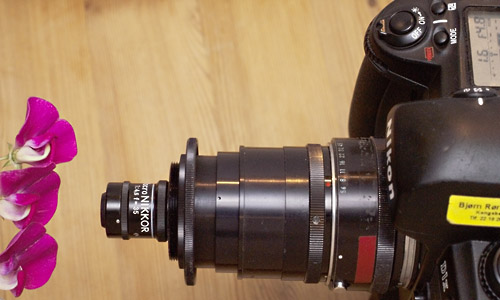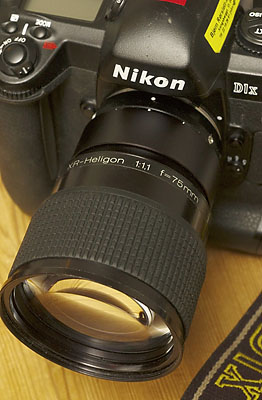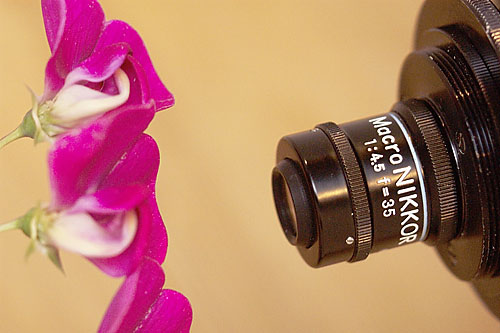The Circle is Closed:
Chips to the Rescue
by
Bjørn Rørslett |
|
| |
|
True macro lenses,
designed for the high magnication rates found in
photomacrography, are professional tools of high optical
performance and, not unexpectedly, with a commensurate steep
asking price. The needs in the field of photomacrography don't
follow the whims and hyped trends so frequently encountered in
other branches of photography. For demanding macro work, the old
and trustworthy lenses were, and still are, the optimal tools to
get the job done. What a pity the manufacturers of these optical
gems don't allow such superb optics to be put to advantage with
their newest digital cameras. No fancy colour or matrix metering
is possible, and some cameras won't even meter with such lenses.
Or is this the end of story? Read on to learn more.
After I had a number of my
manual Nikkors chip-modified by Rolland Elliott or myself to make them work on F5 and D1/D1X/D1H, an idea
dawned on me. Wouldn't a chip inside an extension tube solve the
remaining issues for my macro lenses? And could I, finally,
obtain really precise metering also with the macro lenses or
bellows attachments? My D1-series cameras would meter even with
such contraptions attached to them, but with highly variable and
unreliable results, and using D-TTL flash only exacerbated the
situation. Of course, for a D100 user the question simply is to
get metering at all with manual lenses. So improvements could and
should be sought.
Obviously no linkage to the
lens aperture control should be active, because stop-down
metering has to be used for the candidate lenses for proper macro
work, be they dedicated macro lenses or just ordinary lenses used
in a reversed position. If the extension tube could convey the
aperture on the master lens, this would literally screw up all
metering, because stopped-down metering on any lens with an automatic aperture control is disabled on all new Nikons.

|
| At last:
Using a manual macro lens
on a new Nikon body with full matrix metering capability. Note the M extension
ring mounted between camera and a focusing extension
tube. Refer to the text to help understand its
significance.
© Bjørn
Rørslett/NN
|
Autofocus is a big practical
joke as far as close-up photography is concerned, so losing this
feature is of no concern for photomacrography. Stopped-down
metering may seem old-fashioned, but again, in the
high-magnification field you have to light the specimens with
intense light if you wish to see anything except total blackness
in your viewfinder. So, with a photomacrographic setup work
progresses slowly by its very nature and lacking an automatic
aperture is actually a bonus due to one less item causing
vibration.
One of my sharpest lenses is
the Micro-Nikkor Auto 55 mm f/3.5, from 1967. This lens has a
peculiar compensating aperture mechanism, which means the
aperture changes its effective setting when the lens is focused.
The idea was to give the effective aperture corresponding to the
magnification rate of the lens. This works like a charm of course
when a separate hand-held meter is used for metering, and the
lens set to the indicated aperture value. However, coupled to a
TTL system metering with the lens wide open, the wrong exposure
would result, because the lens would inform the meter of its
nominal setting while in fact a compensated setting was used. The
circuitry found inside today's Micro-Nikkors solves this problem
and communicate the effective aperture to the camera, so no issue
exists (with the possible exception on the user's behalf, because
people fail to understand why a setting of f/2.8 at infinity is
displayed as f/5 at 1:1 with AF Micro-Nikkor 105 lens. Instead of
reading the instruction sheets accompanying their lens, they post
silly questions on the Internet).
Anyhow, I had the old
compensating-type 55 mm Micro-Nikkor, which could not be used on
any of my digital cameras even if AI-modified, and the dedicated
"M" extension tube for it. The M ring, superceded by M2
and later the PK13 extension tube, then underwent cybernetic
surgery by adding the chip print from a pedestrian 28-80 Nikkor,
and the metal lens mount from a 35-70 AF Nikkor (both Nikkors
were scavenged from the scrap heap of my Nikon repair facility so
came free. Most repair shops should be able to supply
the needed parts). Which chip used isn't important, but
getting the chip grafted onto the ring is paramount. Any
extension ring could be used as long as there is space to
encompass the chip print board. If you replace the ring's lens
mount with a new already outfitted for mounting the contact
points (see below), the task is eased considerably.

|
| A rear view of the M extension
ring, showing the contacts for the (faked) electronic
communication between the ring and camera. The lens mount
originates from a wrecked AF 35-70 Nikkor, given to me
for free. Its CPU was faulty, so I replaced it with a
print from an AF 28-80, another plastic-fantastic lens
crashed beyond any hope of repair. Also note I have removed the ubiquitous
aperture coupling lever. This is essential to enforce
stopped-down metering with any master lens mounted on the
M ring.
|

|
| A view into the interior of the M
extension ring, to show how the chip and print are tucked
away so as not to interfere with the shooting. A few
judiciously applied drops of superglue keep everything
into position. I might spray the print with flat black
paint in the future. (As events later turned out, I
simply tucked some black flock fabric inside the tube, it
worked just great to prevent any internal reflections). |
Well, that's about it. With
the CPU in the modified M ring, communication to the camera can
be established and the camera is in no position to understand it
has been deceived. Put the aperture on your lens to any suitable
setting, and the camera's meter will track the alterations in
light levels. Switch to matrix, spot, or centre-weighted metering
to your heart's pleasure. Even the latest development, DTTL
flash, will work, but obviously not in "D" mode because
no distance data can be relayed from the extension ring, even
when a "D"-type chip is placed inside it.
I've shot a lot with an
assortment of lenses using my CPU-fortified extension rings and
can testify the exposures now are vastly improved compared to the
previous use of non-modified extension tubes. Sometimes I do
ponder the vacillating trend of evolution, since my F2 AS (1978)
still is able to obtain highly accurate TTL metering with any
lens or optical device mounted on it. But, of course, even the
mighty F2 fails to do D-TTL flash or colour matrix metering. So,
given the modern cameras are to be used, they actually need
having all the chip-mediated assistance they can get if you want
spot-on exposures.
After the initial success with
the M ring, I have modified several other extension tubes and
reversal rings. Besides the M ring, other alternatives would be
the M2 or E2 rings, both of which provide sufficient interior
space to hide away the CPU print. The odd item from the
old-fashioned K-ring set may be pressed into service for this
purpose as well. Some of prints need to be folded up once or
twice to fit into the tubes. For the ultra-thin K1 ring, the
print has to be hung outside of the ring because there is no
physical space for any of the print, except for the electric
contact points, inside the K1 itself. I have to make the K1 setup
more suitable for field use by encasing the print in laminated
plastics to make it water-tight. A project for the next upcoming
period of low activity, whenever (or if) this happens.

|
Lord
of the Rings
In conjunction
with the Nikkor 20 mm f/3.5 AI/AIS, known for its superb
flare and ghosting control, an ultrathin K1 ring is
perfect for getting those close-ups with dramatic steep
perspective. Getting a chip implanted in the K1 calls for
dedication and some ingenuity, and the print has to be
dangling outside because it is physically impossible to
tuck the chip away inside the narrow ring itself. Only a
few lenses will fit because of possible conflicts between
the lens parts and the print contacts.
Be aware that
even the standard K1-ring may need some trimming to
safely clear the AF contacts of modern cameras.
© Bjørn
Rørslett/NN
|
Another use of the chips is
for some of my highly exotic lenses, such as the super-speed
Rodenstock Heligons. The latest addition, XR-Heligon 75 mm f/1.1,
has just got a chip permantly grafted onto it. For the 50 mm
f/0.75 lens, I have used a chip-equipped narrow extension ring,
but depending on the practical shooting experience from the 75 mm
lens, I might implant a chip on the shorter lens, too.

|
| A true speed monster, the
Rodenstock XR-Heligon 75 mm f/1.1, enters a new existence
outfitted with an "F" lens mount and a matrix
chip (hidden inside the rear metal sleeve, taken from a
lenscap for a 16 mm Fisheye). © Bjørn Rørslett/NN
|

|
| One of the
superb manual macro lenses, from times long past, 35 mm
f/4.5 Macro-Nikkor, springs to a rejuvenated new life in
digital photomacrography © Bjørn Rørslett/NN
|
All modern Nikon
bodies have sculptured outlines which conflict with items such as
a bellows. Hence a narrow extension ring is needed for correct
spacing anyway, otherwise the camera won't mount on the bellows.
Put the modified M ring as a spacer and suddenly all modern
camera features such as colour and matrix metering are available
to your digital close-up and photomacrographic system. Neat,
isn't it?

|
| To make a non-G chip work
on a D100 or F80/N80, you need to add a small tab at the
8 o'clock position (arrowed). (No internal lens
baffle is mounted here, so some screw holes are open) © Rune Nilsson /Opplandsbilder 2002
|
For Nikon D1-series
models, any D, non-D, or G chip can be used, while D100 or
similarly designed cameras need the G-type prints for the
modified extension tubes. Alternatively, a stop-down tab can be
added to the extension ring (see picture above). Whichever chip
is used, you have to pay attention so as to have it set to its maximum aperture
value (G lenses default to
have apertures dialled on the camera and this overrides any
custom setting for aperture control mode). This is needed every
time the ring is attached to the camera and the previously
employed aperture doesn't coincide with the value reported by the
modified tube. Otherwise the camera, which you have tricked into
thinking a real CPU-equipped lens was mounted, may strike back
and play havoc with the exposure. If you use D1-series cameras
programmed to set apertures directly on the lenses, my preferred
setup, non-G chips will work perfectly and you won't be troubled
with the caveat described earlier.

|
Professional
photomacrography in the Third Millenium
My
lab facilities for photomacrography eventually reached
the digital age!
My Nikon Multiphot with a Nikon D1H
camera mounted on the long bellows together with the
chip-modified M-ring. Even a D100 camera would work
perfectly here because the M-ring is equipped with a
"G"-chip inside and thus can communicate with
all newer Nikon bodies.
The camera is controlled from a
networked Toshiba laptop using firewire connection and
Nikon Capture software. NEF files are transferred by
firewire and stored on my photography server for later
processing. Photomacrographic workflow is easier than
ever before. Just click a mouse button and the image file
effortlessly flows through my digital photographic
work-line. I can even remotely control the computer
controlling the camera, and thus surf the Internet, enjoy
a nice cup of coffee, receive e-mails, annotate the
images, update my image database, and watch TV on my main
workstation while digital photomacrographic work is in
progress. Life as a hard-working photomacrographer could
scarcely be more relaxed than this.
Other paraphernalia on the picture
are Macro-Nikkor 65 mm f/4.5 lens on the Multiphot
bellows, fibre-optical cold light fixtures (FI L151
Fiber-Optic Heim AG, and Gossen GKL 500 F with
microflash), and - surprise - a venerable Nikon F2! It
belongs to my basic photomacrographic setup, but why
should a
stone-age F2 be here in first
place?
The answer to that vexing question
is because no modern SLR can give adequate focusing
accuracy in the extreme magnification range of the
Multiphot, an F2 with 6X magnifying finder and M-type
clear screen with cross-hairs is needed for critical
parallax focusing. Technical progress entails by no
means evolutionary logic, and newer isn't always in all
respects better.
|
| The Circle is Closed:
Chips to the Rescue |
|
| |







